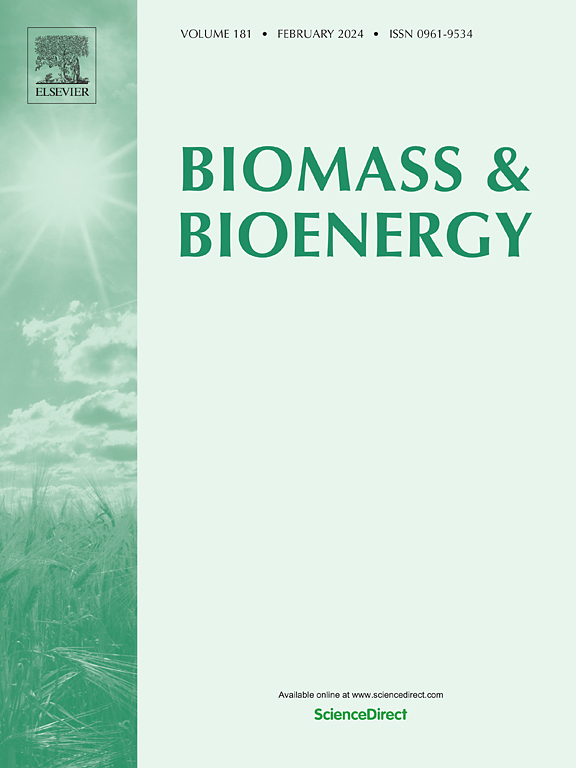海洋生物质废物转化能源及加工废弃物研究进展
IF 5.8
2区 生物学
Q1 AGRICULTURAL ENGINEERING
引用次数: 0
摘要
海洋生物质和鱼类副产品是一种未充分利用的资源,经常被渔业和加工业作为废物丢弃,但具有巨大的生物能源潜力。本文综述了它们在燃烧、热解和气化等热化学过程中作为原料的用途。本文讨论了这些转化方法的最新进展,并对鱼类废物、大型藻类、微藻类和贝类进行了详细的热化学表征,以更好地了解它们的能量潜力。数以吨计的鱼废物可以通过燃烧转化为热量,碳转化效率高达84%。此外,热解产生的生物炭的固定碳含量高达78 wt%,热值达到26 MJ kg−1,由于氮含量高,因此适合用于能源和土壤调节。热解生物油收率从17 wt%到50 wt%不等。这种生物油可以通过酯交换反应升级为生物柴油,转化效率为98.2%,产生的燃料热值为43 MJ kg−1。鳞片、骨头和贝壳是很有前途的多相催化剂来源,也有利于从其他生物质中生产生物柴油。这种综合方法促进了废物增值和能源回收,加强了“海洋能源”的概念,推动了更加循环和可持续的生物经济。本文章由计算机程序翻译,如有差异,请以英文原文为准。

Waste-to-energy from marine biomass and processing wastes: A review
Marine biomass and fish by-products represent an underutilized resource, often discarded as waste by the fishing and processing industries, but with great bioenergy potential. This review explores their use as feedstocks in thermochemical processes such as combustion, pyrolysis, and gasification. Recent advancements in these conversion methods are discussed alongside a detailed thermochemical characterization of fish waste, macroalgae, microalgae, and shellfish to better understand their energy potential. Tons of fish waste can be transformed into heat via combustion, reaching up to 84% carbon conversion efficiency. Additionally, pyrolysis yields biochar with a fixed carbon content of up to 78 wt% and higher heating values reaching 26 MJ kg−1, making it suitable for energy and soil conditioning due to high nitrogen fractions. Pyrolytic bio-oil yields range from 17 wt% to 50 wt%. This bio-oil can be upgraded to biodiesel through transesterification, achieving conversion efficiencies of 98.2% and producing a fuel with a calorific value of 43 MJ kg−1. Scales, bones, and shells are promising sources of heterogeneous catalysts, also favoring biodiesel production from other biomasses. This integrated approach promotes waste valorization and energy recovery and strengthens the concept of “energy from the oceans,” driving forward a more circular and sustainable bioeconomy.
求助全文
通过发布文献求助,成功后即可免费获取论文全文。
去求助
来源期刊

Biomass & Bioenergy
工程技术-能源与燃料
CiteScore
11.50
自引率
3.30%
发文量
258
审稿时长
60 days
期刊介绍:
Biomass & Bioenergy is an international journal publishing original research papers and short communications, review articles and case studies on biological resources, chemical and biological processes, and biomass products for new renewable sources of energy and materials.
The scope of the journal extends to the environmental, management and economic aspects of biomass and bioenergy.
Key areas covered by the journal:
• Biomass: sources, energy crop production processes, genetic improvements, composition. Please note that research on these biomass subjects must be linked directly to bioenergy generation.
• Biological Residues: residues/rests from agricultural production, forestry and plantations (palm, sugar etc), processing industries, and municipal sources (MSW). Papers on the use of biomass residues through innovative processes/technological novelty and/or consideration of feedstock/system sustainability (or unsustainability) are welcomed. However waste treatment processes and pollution control or mitigation which are only tangentially related to bioenergy are not in the scope of the journal, as they are more suited to publications in the environmental arena. Papers that describe conventional waste streams (ie well described in existing literature) that do not empirically address ''new'' added value from the process are not suitable for submission to the journal.
• Bioenergy Processes: fermentations, thermochemical conversions, liquid and gaseous fuels, and petrochemical substitutes
• Bioenergy Utilization: direct combustion, gasification, electricity production, chemical processes, and by-product remediation
• Biomass and the Environment: carbon cycle, the net energy efficiency of bioenergy systems, assessment of sustainability, and biodiversity issues.
 求助内容:
求助内容: 应助结果提醒方式:
应助结果提醒方式:


